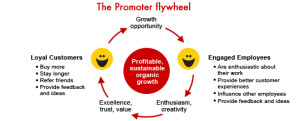Employee Net Promoter Score
Have you heard of the Net Promoter Score (NPS)? It’s a metric based on a single direct question to measure customer loyalty: “How likely is it that you would recommend our product/service to a friend or colleague, on a scale of 0 to 10?” Data is divided this way: 9s and 10s count as “loyal enthusiasts,” 7s and 8s are discarded, and 6s and below are “unhappy customers.” After some fancy calculations, scores can range from -100 (everyone is a detractor) to +100 (everyone is a promoter). Any positive score is considered good. A score of +50 or above is considered excellent. It’s a streamlined way for companies to research what products or services are popular, and what needs to be improved.
We’ve loved the innovative application of this to — you got it — employees themselves (eNPS): “How likely is it that you would recommend our company as a place to work to a friend, on a scale of 0 to 10?” Instead of looking outward, asking it of employees focuses inward, seeing if working for a certain company is excellent, or if the culture needs an overhaul. What an excellent gauge of employer brand. We hugely applaud LEGO for their 2013 eNPS score of 56, and even more so for their determination and plans to increase that score this year.
Seeing the score for employee promoters is a good indicator of how engaged employees are overall — and engaged employees are superheroes of creativity, productivity, innovation, and positive attitude. This image from the NPS website itself sums it up nicely (click to enlarge):
Of course, open-ended (and confidential) follow-up questions are crucial to see specific reasoning and employee ideas for filling in the gaps. One popular way is to ask the standard NPS question — about recommending the company’s product or service to a friend — after the eNPS question. We love supportive research, and we love answering the questions and issues it raises. If you’ve used eNPS or know of someone using it internally, we’d love to hear about it!


